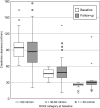Outcome of acute kidney injury with different treatment options: long-term follow-up
- PMID: 20634328
- PMCID: PMC2974373
- DOI: 10.2215/CJN.00770110
Outcome of acute kidney injury with different treatment options: long-term follow-up
Abstract
Background and objectives: The multicenter Stuivenberg Hospital Acute Renal Failure 4 study investigated outcome in patients with acute kidney injury (AKI) stratified according to disease severity by the Stuivenberg Hospital Acute Renal Failure score. Patients in need of renal replacement therapy (RRT) received intermittent RRT or continuous RRT. This study investigated long-term mortality, renal function, comorbidity, and quality of life.
Design, setting, participants, & measurements: All AKI hospital survivors were included. Mortality at 1 and 2 years of follow-up was traced for all patients. Between 1 and 2 years after hospital discharge, survivors were visited at home to determine morbidity (renal function), comorbidity (Charlson comorbidity index [CCI]), and quality of life (Medical Outcome Survey SF-36).
Results: The baseline population consisted of 595 AKI patients. Mortality rates were 23.0 and 7.6%, respectively, during the first and second year after discharge. Total mortality increased from 50.7% at discharge to 65.7% 2 years after AKI and was not related to disease severity or treatment modality offered during hospitalization. Two hundred four survivors could be visited at home. Mean serum creatinine did not differ between discharge and follow-up. CCI was only related with age. SF-36 scores were negatively correlated with CCI, age, and body mass index, but not with disease severity, renal function, or dialysis modality.
Conclusions: Long-term outcome of AKI consists of a high additional mortality unrelated to treatment modality offered during hospitalization, varying evolution of renal recovery, and many comorbidities, but a mental health at the same level as the general population.
Figures






References
-
- Bellomo R, Ronco C, Kellum JA, Metha RL, Palevsky P; Acute Dialysis Quality Initiative Workgroup: Acute renal failure: Definition, outcome measures, animal models, fluid therapy and information technology needs: The Second International Consensus Conference of the Acute Dialysis Quality Initiative (ADQI) Group. Crit Care 8: R204–R212, 2004 - PMC - PubMed
-
- Uchino S, Kellum JA, Bellomo R, Doig GS, Morimatsu H, Morgera S, Schetz M, Tan I, Bouman C, Macedo E, Gibney N, Tolwani A, Ronco C; Beginning and Ending Supportive Therapy for the Kidney (BEST Kidney) Investigators: Acute renal failure in critically patients: a multinational, multicenter study. JAMA 294: 813–818, 2005 - PubMed
-
- de Mendonça A, Vincent JL, Suter PM, Moreno R, Dearden NM, Antonelli M, Takala J, Sprung C, Cantraine F: Acute renal failure in the ICU: Risk factors and outcome evaluated by the SOFA score. Intensive Care Med 26: 915–921, 2000 - PubMed
-
- Liano F, Pascual J: Epidemiology of acute renal failure: a prospective, multicenter, community-based study. The Madrid Acute Renal Failure Study Group. Kidney Int 50: 811–818, 1996 - PubMed
-
- Brivet FG, Kleinknecht DJ, Loirat P, Landais PJ: Acute renal failure in intensive care units: Causes, outcome, and prognostic factors of hospital mortality: A prospective, multicenter study. French Study Group on Acute Renal Failure. Crit Care Med 24: 192–198, 1996 - PubMed
Publication types
MeSH terms
Substances
LinkOut - more resources
Full Text Sources

